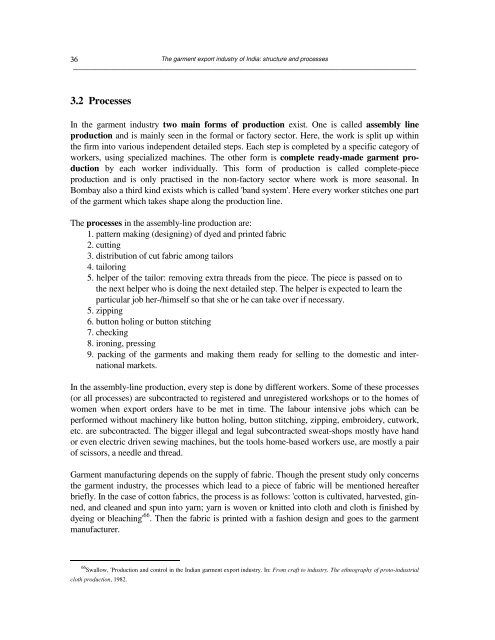Create successful ePaper yourself
Turn your PDF publications into a flip-book with our unique Google optimized e-Paper software.
36<br />
The <strong>garment</strong> <strong>export</strong> <strong>in</strong>dustry <strong>of</strong> <strong>India</strong>: structure <strong>and</strong> processes<br />
──────────────────────────────────────────────────────────────────────────────────────────────<br />
3.2 Processes<br />
In <strong>the</strong> <strong>garment</strong> <strong>in</strong>dustry two ma<strong>in</strong> forms <strong>of</strong> production exist. One is called assembly l<strong>in</strong>e<br />
production <strong>and</strong> is ma<strong>in</strong>ly seen <strong>in</strong> <strong>the</strong> formal or factory sector. Here, <strong>the</strong> work is split up with<strong>in</strong><br />
<strong>the</strong> firm <strong>in</strong>to various <strong>in</strong>dependent detailed steps. Each step is completed by a specific category <strong>of</strong><br />
workers, us<strong>in</strong>g specialized mach<strong>in</strong>es. The o<strong>the</strong>r form is complete ready-made <strong>garment</strong> production<br />
by each worker <strong>in</strong>dividually. This form <strong>of</strong> production is called complete-piece<br />
production <strong>and</strong> is only practised <strong>in</strong> <strong>the</strong> non-factory sector where work is more seasonal. In<br />
Bombay also a third k<strong>in</strong>d exists which is called 'b<strong>and</strong> system'. Here every worker stitches one part<br />
<strong>of</strong> <strong>the</strong> <strong>garment</strong> which takes shape along <strong>the</strong> production l<strong>in</strong>e.<br />
The processes <strong>in</strong> <strong>the</strong> assembly-l<strong>in</strong>e production are:<br />
1. pattern mak<strong>in</strong>g (design<strong>in</strong>g) <strong>of</strong> dyed <strong>and</strong> pr<strong>in</strong>ted fabric<br />
2. cutt<strong>in</strong>g<br />
3. distribution <strong>of</strong> cut fabric among tailors<br />
4. tailor<strong>in</strong>g<br />
5. helper <strong>of</strong> <strong>the</strong> tailor: remov<strong>in</strong>g extra threads from <strong>the</strong> piece. The piece is passed on to<br />
<strong>the</strong> next helper who is do<strong>in</strong>g <strong>the</strong> next detailed step. The helper is expected to learn <strong>the</strong><br />
particular job her-/himself so that she or he can take over if necessary.<br />
5. zipp<strong>in</strong>g<br />
6. button hol<strong>in</strong>g or button stitch<strong>in</strong>g<br />
7. check<strong>in</strong>g<br />
8. iron<strong>in</strong>g, press<strong>in</strong>g<br />
9. pack<strong>in</strong>g <strong>of</strong> <strong>the</strong> <strong>garment</strong>s <strong>and</strong> mak<strong>in</strong>g <strong>the</strong>m ready for sell<strong>in</strong>g to <strong>the</strong> domestic <strong>and</strong> <strong>in</strong>ternational<br />
markets.<br />
In <strong>the</strong> assembly-l<strong>in</strong>e production, every step is done by different workers. Some <strong>of</strong> <strong>the</strong>se processes<br />
(or all processes) are subcontracted to registered <strong>and</strong> unregistered workshops or to <strong>the</strong> homes <strong>of</strong><br />
women when <strong>export</strong> orders have to be met <strong>in</strong> time. The <strong>labour</strong> <strong>in</strong>tensive jobs which can be<br />
performed without mach<strong>in</strong>ery like button hol<strong>in</strong>g, button stitch<strong>in</strong>g, zipp<strong>in</strong>g, embroidery, cutwork,<br />
etc. are subcontracted. The bigger illegal <strong>and</strong> legal subcontracted sweat-shops mostly have h<strong>and</strong><br />
or even electric driven sew<strong>in</strong>g mach<strong>in</strong>es, but <strong>the</strong> tools home-based workers use, are mostly a pair<br />
<strong>of</strong> scissors, a needle <strong>and</strong> thread.<br />
Garment manufactur<strong>in</strong>g depends on <strong>the</strong> supply <strong>of</strong> fabric. Though <strong>the</strong> present study only concerns<br />
<strong>the</strong> <strong>garment</strong> <strong>in</strong>dustry, <strong>the</strong> processes which lead to a piece <strong>of</strong> fabric will be mentioned hereafter<br />
briefly. In <strong>the</strong> case <strong>of</strong> cotton fabrics, <strong>the</strong> process is as follows: 'cotton is cultivated, harvested, g<strong>in</strong>ned,<br />
<strong>and</strong> cleaned <strong>and</strong> spun <strong>in</strong>to yarn; yarn is woven or knitted <strong>in</strong>to cloth <strong>and</strong> cloth is f<strong>in</strong>ished by<br />
dye<strong>in</strong>g or bleach<strong>in</strong>g' 66 . Then <strong>the</strong> fabric is pr<strong>in</strong>ted with a fashion design <strong>and</strong> goes to <strong>the</strong> <strong>garment</strong><br />
manufacturer.<br />
66 Swallow, 'Production <strong>and</strong> control <strong>in</strong> <strong>the</strong> <strong>India</strong>n <strong>garment</strong> <strong>export</strong> <strong>in</strong>dustry. In: From craft to <strong>in</strong>dustry. The ethnography <strong>of</strong> proto-<strong>in</strong>dustrial<br />
cloth production, 1982.


















